Gabions Products
- Military Gabions

- Hot Dipped Galvanized Gabion Mesh Cells

- Welded Mesh Gabions Architectural Wall Cladding

- Gabions (Gabiony)
- Galfan + PVC Coated Gabions
- Gabion Mattresses for Flood Protection Embankment
- Planted Gabion Walls

- Gabions and Geotextiles for Bridge Construction
- Gabions P. V. C. Coated Galvanised Wire Box
- Gabions River Training Works
- Geotextile Fabric
- Woven Wire Mesh Cages for Gabion Project
- Gabion Fence
- Welded Gabions Coating Galfan
- Gabion Baskets Double Twisted Galvanized
- Gabion Box
- Woven Gabions
- Gabion Baskets
- Wire Mesh Gabion Mattress
- Gabion Cages (Stone Box)
- Gabion Wall
- Hexagonal Gabions Netting
- Gabions Machine
- Welded Gabions
- Sack Gabions
- Reinforced Gabions
- Gabion faced reinforced soil walls
- Gabion Mattress
- Gabions for Water Conservancy
- Gabions for Bridge Protection System
- Gabion Wall Drop Structures
- Modular Gabions as Architectural Elements
- Gravity Wall of Gabions
- Gabions for Headwalls or Wingwalls
- Channel Linings
- Modular Gabions for Rockfall Netting System
Gabions Products
Box Gabions, Gabion Wall, Baskets and Gabion Mat
A gabion means "big cage" in Italian, means "cage" in Latin, it is a basket or box container filled with rocks, concrete, or sand for use in civil engineering, road building, and military applications.
We supply gabions in various forms:box, cages, baskets, mattress, sacks and etc.Box Gabions, Gabion baskets and mattresses are supplied in rectangular mesh units, fabricated from double-twist hexagonal mesh rolls or galvanized steel wire mesh welded panels. The hexagonal mesh gabions are of soft annealed heavily zinc coated wire and divided into cells with diaphragms, the mesh (except for the diaphragms) shall be reinforced on all edges with wires of a larger diameter.
Stone for Gabions
Stone used for gabions and gabion mattresses shall be clean, natural, hard and durable with a minimum density of 2,650 kg/m3 (solid volume without voids). Stone shall be well graded within the following limits:
|
Minimum Dimension |
Maximum Dimension |
Box gabions |
100 mm |
250 mm |
300 mm mattress |
75 mm |
200 mm |
The stone shall be free from laminations, weak cleavages and undesirable weathering and shall be of such properties that it will not disintegrate from the action of air, water or in handling and placing. The stones will be roughly selected so that they fit reasonably close together. They shall be laid to a true and even surface, the spaces between the stones being clinked with spalls.
Wire Fabric for Gabions
The fabric shall be triple twisted hexagonal woven steel wire mesh. The wire shall be galvanized before weaving.
Wire thickness and mesh size shall be as follows:
|
Minimum Wire Diameter |
Maximum Mesh Size |
Tolerance standard mesh wire |
Box gabions |
2.7 mm |
80 x 100 mm |
-4 +10 mm |
300 mm mattress |
2.0 mm |
60 x 80 mm |
|
Filter Cloth
The filter cloth shall be a non-woven material to the approval of the Engineer. The filter cloth shall be resistant to chemical and biological degradation from all naturally occurring minerals and bacteria. The filter cloth shall be permeable and capable passing at 100 mm head of water with a uniform pore size distribution from 0.02 to 0.15 mm.
The filter cloth shall be laid on a prepared formation or in a prepared trench and shall be overlapped at joints by not less than 0.5 m and shall be laid strictly in accordance with the recommendations of the manufacturer.
Foundation Preparation
The foundation on which gabions are to be placed shall be level and graded to the elevations as shown on the project drawings, and free of surface irregularities, loose material, and vegetation in accordance with the project specifications. Appropriate measures must be taken for drainage around the foundation, as per project specification (geotextile, drain works, etc.). Geotextiles installed behind gabion structure shall comply with the requirements for surface drainage applications.
Installation and Filling of Pre Fabricated Gabion Units in forms of boxes, cages, baskets
After the foundation has been prepared, the pre-assembled gabions shall be placed in position empty, and tied or fastened to adjacent gabion units along all edges in order to form a continuously connected, monolithic structural unit. Adjoining gabions and gabion mattresses shall be firmly wired together to give a continuous joint along all adjacent edges.
Where gabions are placed on filter cloth care shall be taken to avoid puncturing the cloth during erection.
Rocks for the gabions may be produced by any suitable quarrying method, and by the use of any device that yields the required sizes within the gradation limits chosen. Rocks shall be hard, angular to round, durable and of such quality that they shall not disintegrate on exposure to water or weathering during the life of the structure.
Rocks shall range between 100 mm and 250 mm. The range in sizes may allow for a variation of 5% oversize and/or 5% undersize rock, provided it is not placed on the exposed surface. In all cases, the oversize rock shall not be larger than 300 mm, and the undersize rock shall not be smaller than 50 mm. Rock shall be placed in 300 mm lifts for 1 m high gabion units, and 250 mm for 0.5 m high units. The fill layer shall never be more than 300 mm higher than any adjoining cell. Care shall be taken when placing the stone to ensure that the wire is not damaged. After a layer of rock has been placed in the cell, sufficient hand manipulation of the rock shall be performed to minimize voids and to achieve a maximum density of the rock in the gabion. The rock in exposed vertical faces shall be hand placed to reduce voids in the outer face and to achieve an even surface.
Stiffeners or internal cross ties shall be installed connecting the front and back faces of any supported or exposed face at the vertical third points for a 1 m high gabion unit, as the cell is being filled.
Gabion units installed at the wall ends, having two exposed sides, shall also include a set of cross ties installed perpendicularly to the lateral exposed face. For 0.5 m high baskets when used as revetment, stiffeners or internal cross ties are not required. When more than one vertical layer of gabions is installed, units shall be overfilled to approximately 25 to 40 mm to allow natural settlement. The top surface shall be smoothly levelled, minimising voids.
Where shown on the drawings or otherwise directed, the gabion mesh shall be cut, folded and wired together to form mitre joints, angles, curves or slopes which are not possible to obtain in the structures with the standard rectangular gabions. The mesh must be cleanly cut and the surplus mesh cut completely out, or folded back and neatly wired to an adjacent gabion face. The cut edges of the mesh shall be securely laced together With binding wire.
Closing
After the rock has been levelled and the voids minimised, the lid shall be fold down and the edges of the panels have to be pulled together. It should require a light stretching using an appropriate closing tool or lid closer in order to bring the two gabion pieces together. Care shall be taken that the mesh is not deformed or the wire is damaged. The projecting selvedge wire of the lid shall be wrapped two complete turns around the selvedge wire or edge wire on the sides. The lid shall be tightly tied along all edges, ends and tops of diaphragms. Adjacent lids may be tied or attached simultaneously. All projecting sharp ends of wire shall be turned in on the completed gabion structure.
Geotextiles Quality and Standards
Geotextiles shall conform to the requirements of DIN EN 13253, DIN EN ISO 10319. Tensile strength shall be > 120 kN/rn.
Geotextile Storage
Before use, the geotextile shall be stored in a clean, dry location out of direct sunlight, not subject to extremes of either hot or cold temperatures, and with the manufacturer's protective cover undisturbed.
Surface preparation
The surface on which the geotextile is to be placed shall be graded and be smooth and free of loose rock and clods, holes, depressions, projections, muddy conditions, and standing or flowing water.
Placement
Before the geotextile is placed, the soil surface shall be inspected by the Engineer. The geotextite shall be placed on the approved prepared surface. It shall be unrolled along the placement area and loosely laid, without stretching, in such a manner that it conforms to the surface irregularities when material or gabions are placed on or against it. The geotextile may be folded and overlapped to permit proper placement. The geotextile shall be joined by overlapping a minimum of 0.5 m (unless otherwise specified) and secured against the underlying foundation material. Securing pins, approved and provided by the geotextile manufacturer, shall be placed along the edge of the panel or roll material to adequately hold it in place during installation. Pins shall be steel or fiberglass formed as a U, L, or T shape or contain "ears" to prevent total penetration through the geotextile. Steel washers shall be provided on all but the U-shaped pins. The upstream or upslope geotextile shall overlap the abutting downslope geotextile. At vertical laps, securing pins shall be inserted through the bottom layers along a line through approximately the mid-point of the overlap. At horizontal laps and across slope labs, securing shall be inserted through the bottom layer only. Securing pins shall be placed along a line 5 cm in from the edge of the placed geotextile at intervals not to exceed 30 cm unless otherwise specified. Additional pins shall be installed as necessary and where appropriate to prevent any undue slippage or movement of the geotextile. The use of securing pins will be held to the minimum necessary. Pins are to remain in place unless otherwise specified.
Should the geotextile be torn or punctured, or the overlaps or sewn joint disturbed, as evidenced by visible geotextile damage, subgrade pumping, intrusion, or grade distortion, the backfill around the damaged or displaced area shall be removed and restored to the original approved condition. The repair shall consist of a patch of the same type of geotextile being used and overlaying the existing geotextile. When the geotextile seams are required to be sewn, the overlay patch shall extend a minimum of 30 cm beyond the edge of any damaged area and joined by sewing as required for the original geotextile except that the sewing shall be a minimum of 15 cm from the edge of the damaged geotextile. Geotextile panels joined by overlap shall have the patch extend a minimum of 50 cm from the edge of any damaged area.
Measurement
The quantity of geotextile for each type placed within the specified limits is determined by measurements of the covered surfaces only, disregarding that required for anchorage, seams, and overlaps.
Gabion Products
 |
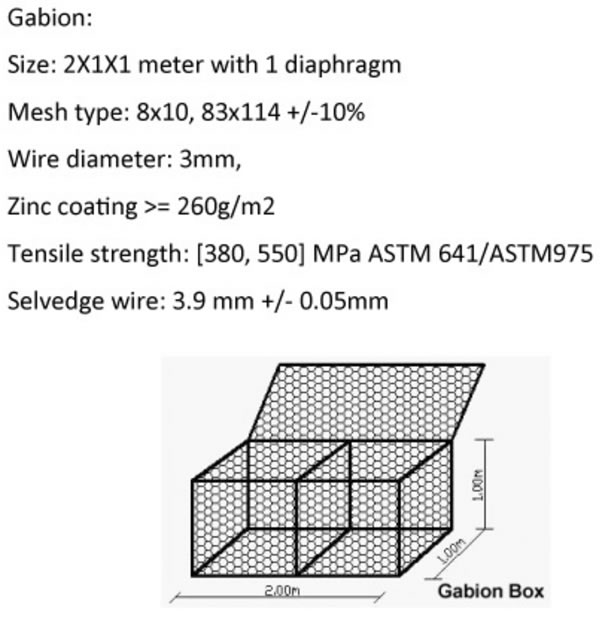 |
| Gabions (Gabiony) | Gabion Baskets |
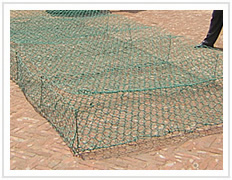 |
 |
| Woven Wire Gabions | Gabion Baskets |
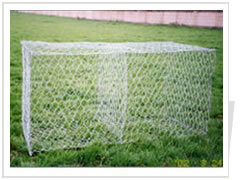 |
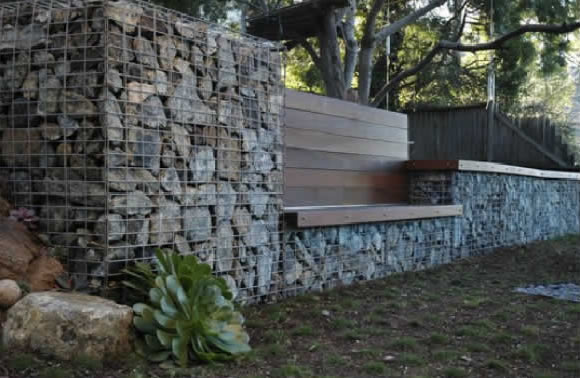 |
| Gabion Cages (Stone Box) | Gabion Wall |
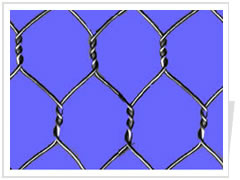 |
 |
| Hexagonal Wire Netting | Gabion Machine |
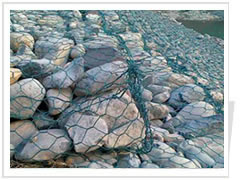 |
|
| Galfan + PVC Coated Gabions |
